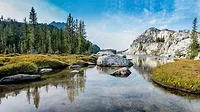PepsiCo, Nature Conservancy announce new water conservation projects
Collaboration tackles water scarcity and boosts local communities in Southwestern States.

To mark World Water Day last week, PepsiCo and The Nature Conservancy announced new projects to conserve and replenish water in the Southwestern United States, marking the next stage of their multi-year national collaboration.
In 2016, PepsiCo announced its goal to return all the water that it consumes in manufacturing operations located in high water-risk areas to the same watershed from which it is taken, by 2025. The collaboration that the global food and beverage company has formed with The Nature Conservancy is at the heart of its strategy for achieving this goal.
The Salt and Verde Alliance, which brings together communities, corporations, farmers, and other organizations with an interest in the Salt and Verde watershed, is emblematic of the innovative and holistic approach that the collaboration is taking in the Southwest region.
In 2017, PepsiCo's support for projects managed under this Alliance enabled 110 million gallons of water to be replenished in the Verde River valley. As part of this, The Nature Conservancy helped Hauser and Hauser Farms, the largest multi-generational farm in the area, to switch from flood irrigation to a more efficient drip irrigation technique, keeping more water in the Verde River.
A new 2018 project, detailed today, is supporting the same farm in switching from cultivation of alfalfa to barley, a crop that utilizes water primarily when the river's level is naturally at its highest, and limits water withdrawal during dry months.
As part of this project, The Nature Conservancy and partners are also announcing the opening of Arizona's first malt house, which aims to help producers maximize revenue from barley, making it a more financially viable alternative crop and helping to encourage other farmers to make similar crop changes.
"These projects bring together farmers and other key stakeholders to address local watershed challenges in a collaborative way," says Roberta Barbieri, V.P. Global Sustainability, PepsiCo. "Our approach is underscored by a belief that, by considering environmental, social and economic factors together, sustainable, systemic change can be brought about. The Nature Conservancy's work in the Verde and Salt River valleys, with PepsiCo's support, is a model for how high risk watersheds around the world can be sustainably managed."
The Verde and Salt River valleys are part of the wider Colorado River system, which is the primary source of water across the Southwest. The shared goal of PepsiCo and The Nature Conservancy is to maximize the health and vibrancy of the system through scalable solutions for integrated water management. Alongside the successful extension of PepsiCo and The Nature Conservancy's work in Arizona, additional new projects announced today to make further progress towards that vital goal include:
The planned acquisition by The Nature Conservancy, supported by PepsiCo, of land and water rights on the Price River, Utah. This will allow for the implementation of innovative measures to protect local water flows and ecosystems. The project is expected to enhance water flows in both the Price and Green rivers, benefitting drinking water sources, agricultural communities and endangered fish. This is a long-term project, intended to deliver over 200 million gallons (750 million liters) of water benefits every year.
At Cibolo Bluffs, Texas, PepsiCo is supporting The Nature Conservancy's management of a 5,000 acre preserve to safeguard an aquifer that provides water for almost two million Central Texans. This project also protects the habitat for the largest population of bats in the world — 20 million Mexican free-tailed bats.
Looking for a reprint of this article?
From high-res PDFs to custom plaques, order your copy today!







